2003 Oldsmobile Alero mirror
[x] Cancel search: mirrorPage 189 of 354
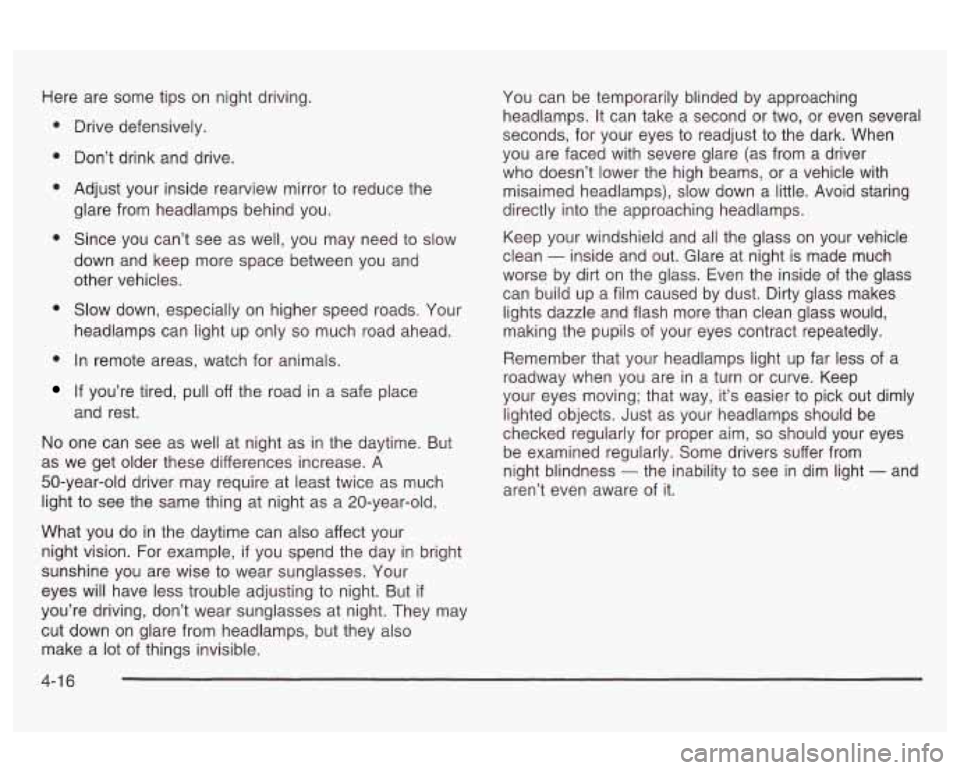
Here are some tips on night driving.
e
e
e
Drive defensively.
Don’t drink and drive.
Adjust your inside rearview mirror to reduce the
glare from headlamps behind you.
Since you can’t see as well, you may need to slow
down and keep more space between you and
other vehicles.
Slow down, especially on higher speed roads. Your
headlamps can light up only
so much road ahead.
In remote areas, watch for animals.
If you’re tired, pull off the road in a safe place
and rest.
No one can see as well at night as in the daytime. But
as we get older these differences increase. A
50-year-old driver may require at least twice as much
light to see the same thing at night as a 20-year-old.
What you do in the daytime can also affect your
night vision. For example,
if you spend the day in bright
sunshine you are wise to wear sunglasses. Your
eyes will have less trouble adjusting to night. But
if
you’re driving, don’t wear sunglasses at night. They may
cut down on glare from headlamps, but they also
make a lot of things invisible. You
can be temporarily blinded by approaching
headlamps. It can take a second or two, or even several
seconds, for your eyes to readjust
to the dark. When
you are faced with severe glare (as from a driver
who doesn’t lower the high beams, or a vehicle with
misaimed headlamps), slow down a little. Avoid staring
directly into the approaching headlamps.
Keep your windshield and all the glass on your vehicle
clean
- inside and out. Glare at night is made much
worse by dirt on the glass. Even the inside of the glass
can build up a film caused by dust. Dirty glass makes
lights dazzle and flash more than clean glass would,
making the pupils of your eyes contract repeatedly.
Remember that your headlamps light up far less of a
roadway when you are in a turn or curve. Keep
your eyes moving; that way, it’s easier
to pick out dimly
lighted objects. Just as your headlamps should be
checked regularly for proper aim,
so should your eyes
be examined regularly. Some drivers suffer from
night blindness
- the inability to see in dim light - and
aren’t even aware of it.
4-1 6
Page 194 of 354

Freeway Driving
Mile for mile, freeways (also called thruways, parkways,
expressways, turnpikes or supernignwaysj are
ine
safest of all roads. But they have their own special rules.
The most important advice on freeway driving is:
Keep up with traffic and keep to the right. Drive at the
same speed most of the other drivers are driving.
Too-fast or too-slow driving breaks a smooth traffic iiow.
Treat the left lane on a freeway as a passing lane. At
the entrance, there is usually a ramp that leads to
the freeway.
If you have a clear view of the freeway as
you drive along the entrance ramp, you should begin
to check traffic. Try to determine where you expect
to blend with the flow. Try to merge into the gap at close
to the prevailing speed. Switch on your turn signal,
check your mirrors and glance over your shoulder as
often as necessary. Try to blend smoothly with the
traffic flow.
Once you are on the freeway, adjust your speed to the
posted limit or to the prevailing rate
if it’s slower.
Stay in the right lane unless you want to pass.
Before changing lanes, check your mirrors. Then use
your turn signal.
Just before you leave the lane, glance quickly over your
shoulder to make sure there isn’t another vehicle in
your “blind” spot.
Once you are moving on the freeway, make certain you
allow a reasonable following distance.
Expect to move slightly slower at night.
When you want to leave the freeway, move to the
proper lane well
in advance. If you miss your exit, do
not, under any circumstances, stop and back up. Drive
on to the next exit.
4-2 1
Page 196 of 354

What can you do about highway hypnosis? First, be
aware that it can happen.
Then here are some tips:
e
e
e
Make sure your vehicle is well ventilated, with a
comfortably cool interior.
Keep your eyes moving. Scan the road ahead and
to the sides. Check your rearview mirrors and your
instruments frequently.
If you get sleepy, pull off the road into a rest,
service
or parking area and take a nap, get some
exercise, or both. For safety, treat drowsiness
on the highway as an emergency.
Hill and Mountain Roads
Driving on steep hills or mountains is different from
dri\/iy Y i~ f!& cy +!inn tnrrain 3 --..I....
4-23
Page 213 of 354

Driving with a Trailer
Towing a trailer requires a certain amount of experience.
Before setting out for the open road, you’ll want to get
to know your rig. Acquaint yourself with the feel of
handling and braking with the added weight of the trailer.
And always keep in mind that the vehicle you are
driving is now a good deal longer and not nearly as
responsive as your vehicle is by itself.
Before you start, check the trailer hitch and platform
(and attachments), safety chains, electrical connector,
lamps, tires and mirror adjustment.
If the trailer has
electric brakes, start your vehicle and trailer moving and
then apply the trailer brake controller by hand to be
sure the brakes are working. This lets you check your
electrical connection at the same time.
During your trip, check occasionally to be sure that the
load is secure, and that the lamps and any trailer
brakes are still working.
Following Distance
Stay at least twice as far behind the vehicle ahead as
you would when driving your vehicle without a trailer.
This can help you avoid situations that require
heavy braking and sudden turns.
Passing
You’ll need more passing distance up ahead when
you’re towing a trailer. And, because you’re a good deal
longer, you’ll need to go much farther beyond the
passed vehicle before you can return to your lane.
Backing Up
Hold the bottom of the steering wheel with one hand.
Then, to move the trailer to the left, just move that hand
to the left. To move the trailer to the right, move your
hand to the right. Always back up slowly and,
if possible,
have someone guide you.
Making Turns
Notice: Making very sharp turns while trailering
could cause the trailer to come in contact with the
vehicle. Your vehicle could be damaged. Avoid
making very sharp turns while trailering.
When you’re turning with a trailer, make wider turns
than normal.
Do this so your trailer won’t strike
soft shoulders, curbs, road signs, trees or other objects.
Avoid jerky or sudden maneuvers. Signal well in
advance.
4-40
Page 297 of 354
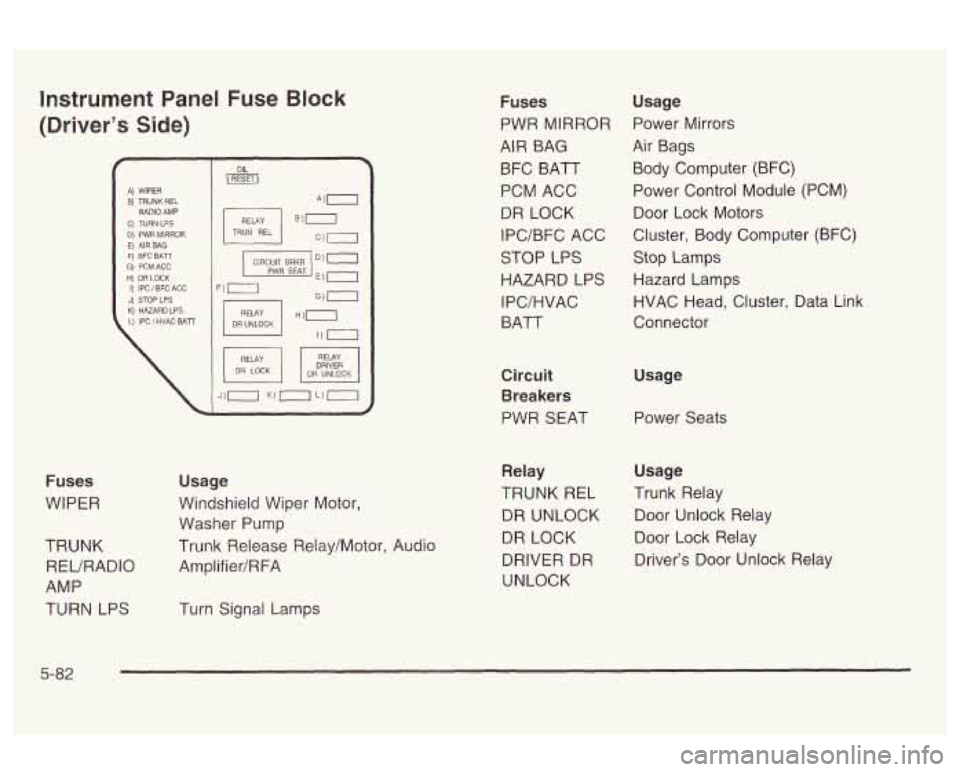
Instrument Panel Fuse Block
(Driver's Side)
f I A) WIPER I
F) EFC BATT G) PCMACC I ti: DALOCK I PWR SEAT E) 0 I) IPC / BFC ACG F) .
DRIVER
Fuses
WIPER
TRUNK REURADIO
AMP
TURN LPS Usage
Windshield Wiper Motor,
Washer Pump
Trunk Release Relay/Motor, Audio
Amplifier/RFA
Turn Signal Lamps
Fuses
PWR MIRROR
AIR BAG
BFC BATT
PCM ACC
DR LOCK
IPC/BFC ACC
STOP LPS
HAZARD LPS
I PC/HVAC
BATT
Circuit Breakers
PWR SEAT Usage
Power Mirrors
Air Bags Body Computer (BFC)
Power Control Module (PCM) Door Lock Motors
Cluster, Body Computer (BFC) Stop Lamps
Hazard Lamps
HVAC Head, Cluster, Data Link
Connector
Usage Power Seats
Relay Usage
TRUNK
REL Trunk Relay
DR UNLOCK Door Unlock Relay
DR LOCK Door Lock Relay
DRIVER DR Driver's Door Unlock Relay
UNLOCK
5-82
Page 299 of 354
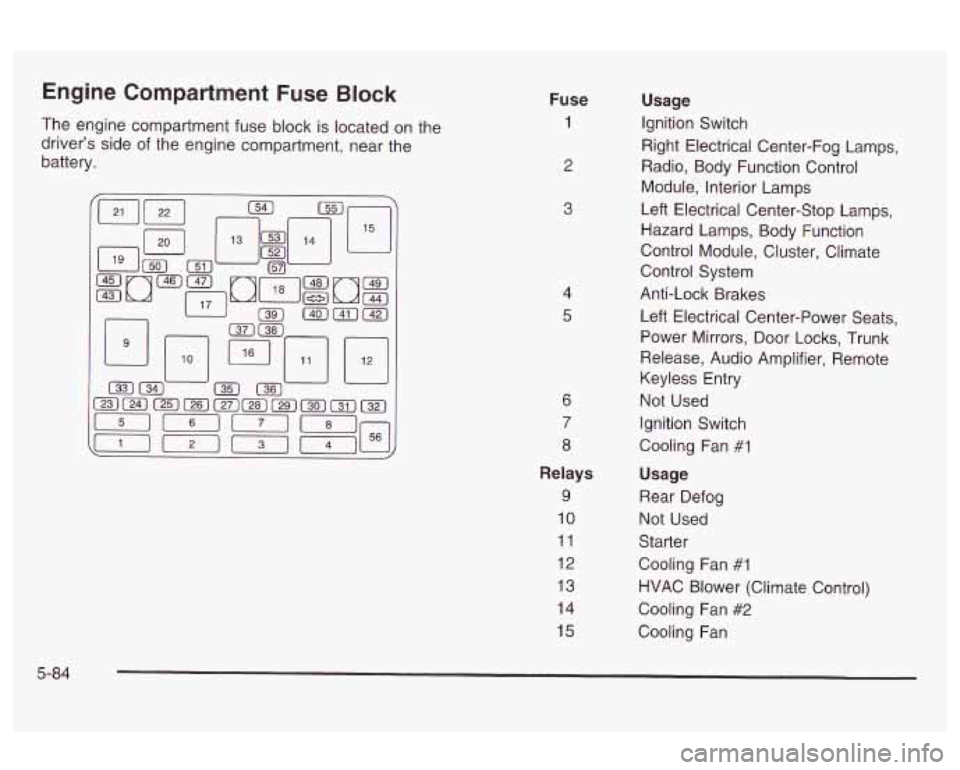
Engine Compartment Fuse Block
The engine compartment fuse block is located on the
driver’s side of the engine compartment, near the
battery. Fuse 1
2
3
4
5
6
7
8
Relays
9
10
11
12
13
14
15
Usage
Ignition Switch
Right Electrical Center-Fog Lamps,
Radio, Body Function Control
Module, Interior Lamps
Left Electrical Center-Stop Lamps,
Hazard Lamps, Body Function
Control Module, Cluster, Climate
Control System
Anti-Lock Brakes
Left Electrical Center-Power Seats,
Power Mirrors, Door Locks, Trunk
Release, Audio Amplifier, Remote
Keyless Entry
Not Used
Ignition Switch
Cooling Fan
#I
Usage
Rear Defog
Not Used
Starter
Cooling Fan
#1
HVAC Blower (Climate Control)
Cooling Fan
#2
Cooling Fan
5-84
Page 342 of 354
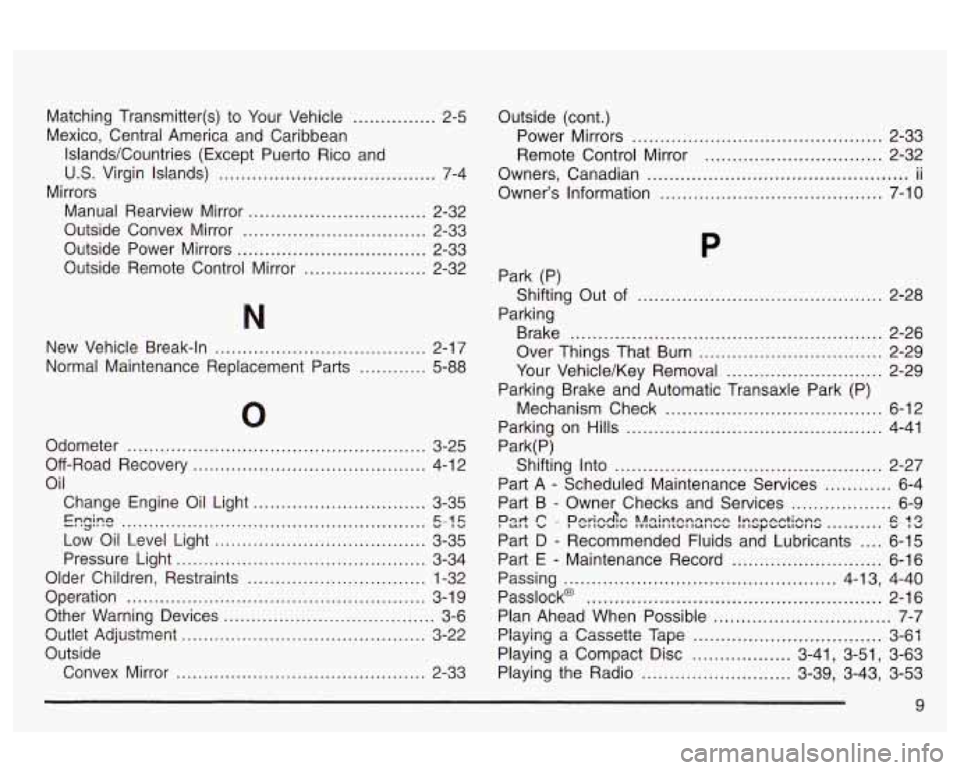
Matching Transmitter(s) to Your Vehicle ............... 2-5
Mexico. Central America and Caribbean
IslandslCountries (Except Puerto Rico and
U.S. Virgin Islands) ....................................... 7-4
Manual Rearview Mirror
................................ 2-32
Outside Convex Mirror
................................. 2-33
Outside Power Mirrors
.................................. 2-33
Outside Remote Control Mirror
...................... 2-32
Mirrors
New Vehicle Break-In
...................................... 2-17
Normal Maintenance Replacement Parts
............ 5-88
0
Odometer ...................................................... 3-25
Off-Road Recovery
.......................................... 4-1 2
Oil Change Engine Oil Light
............................... 3-35
Low Oil bevel Light
...................................... 3-35
Pressure Light
............................................. 3-34
Older Children, Restraints
................................ 1-32
Operation
...................................................... 3-1 9
Other Warning Devices
...................................... 3-6
Outside
Engine ....................................................... " E-! 5
Outlet Adjiisti?ieiit ............................................ 3-22
Convex Mirror ............................................. 2-33 Outside
(cont.)
Power Mirrors
............................................. 2-33
Remote Control Mirror
................................ 2-32
Owners. Canadian
............................................... ii
Owner's Information
........................................ 7-10
Park (P)
Parking Shifting
Out
of ......... ~~~~ ................ 2-28
Brake
............................ ................ 2-26
Over Things That Burn
............................. 2-29
Your Vehicle/Key Removal
............................ 2-29
Parking Brake and Automatic Transax!e Park (P)
Mechanism Check
....................................... 6-12
Parking on Hills
.............................................. 4-41
Park(
P)
Shifting Into ................................................ 2-27
Part A - Scheduled Maintenance Services ............ 6-4
Part B
- Owner Checks and Services .................. 6-9
Part D
- Recommended Fluids and Lubricants .... 6-15
Part
E - Maintenance Record ........................... 6-16
Passing
................................................. 4-13, 4-40
Passlock@
..................................................... 2-16
Plan Ahead When Possible
................................ 7-7
Playing a Cassette Tape .................................. 3-61
Playing a Compact Disc .................. 3-41, 3-51, 3-63
Playing the Radio
........................... 3-39, 3-43, 3-53
I UI k G . Pericdlc ??lzintzn2ncc Inspcticns .......... 8-13
9
Page 343 of 354
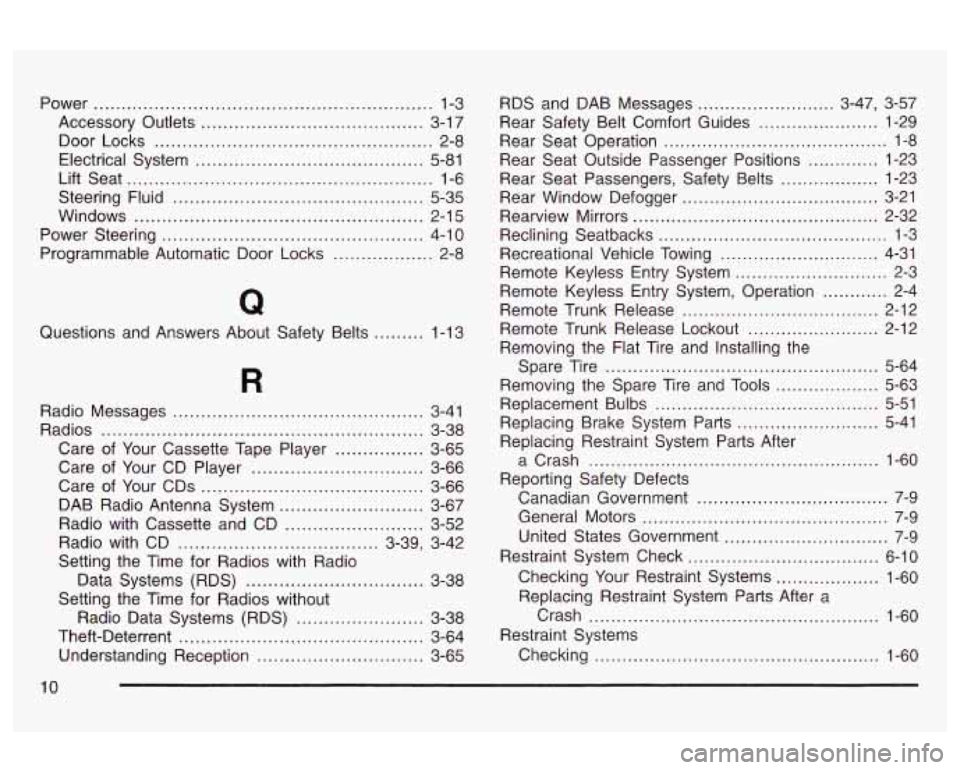
Power ............................................................. 1-3
Accessory Outlets
........................................ 3-1 7
Door Locks .................................................. 2-8
Electrical System
......................................... 5-81
Lift Seat
....................................................... 1-6
Steering Fluid
............................................. 5-35
Windows
.................................................... 2-1 5
Power Steering ............................................... 4-10
Programmable Automatic Door Locks
.................. 2-8
Questions and Answers About Safety Belts
......... 1-13
Radio Messages
.............................................
Radios ..........................................................
Care of Your Cassette Tape Player ................
Care of Your CD Player ...............................
Care of Your CDs ........................................
DAB Radio Antenna System ..........................
Radio with Cassette and CD .........................
Radio with CD .................................... 3.39.
Setting the Time for Radios with Radio
Data Systems (RDS)
................................
Setting the Time for Radios without
Radio Data Systems
(RDS) .......................
Theft-Deterrent ............................................
Understanding Reception ..............................
3-41
3-38
3-65
3-66
3-66 3-67
3-52 3-42
3-38
3-38
3-64
3-65 RDS
and DAB Messages
......................... 3.47. 3-57
Rear Safety Belt Comfort Guides
...................... 1-29
Rear Seat Operation
......................................... 1-8
Rear Seat Outside Passenger Positions
............. 1-23
Rear Window Defogger
.................................... 3-21
Rearview Mirrors
............................................. 2-32
Reclining Seatbacks
.......................................... 1-3
Recreational Vehicle Towing
............................. 4-31
Remote Keyless Entry System
............................ 2-3
Remote Keyless Entry System, Operation
............ 2-4
Remote Trunk Release
.................................... 2-12
Remote Trunk Release Lockout
........................ 2-12
Removing the Flat Tire and Installing the
Spare Tire
.................................................. 5-64
Removing the Spare Tire and Tools
................... 5-63
Replacement Bulbs
......................................... 5-51
Replacing Brake System Parts
.......................... 5-41
Replacing Restraint System Parts After
a Crash
................................................. 1-60
Reporting Safety Defects
Canadian Government
................................... 7-9
General Motors
............................................. 7-9
United States Government
.............................. 7-9
Restraint System Check
................................... 6-10
Checking Your Restraint Systems
................... 1-60
Replacing Restraint System Parts After a
Crash
..................................................... 1-60
Checking
.................................................... 1-60
Rear
Seat Passengers, Safety Belts
.................. 1-23
Restraint Systems
10